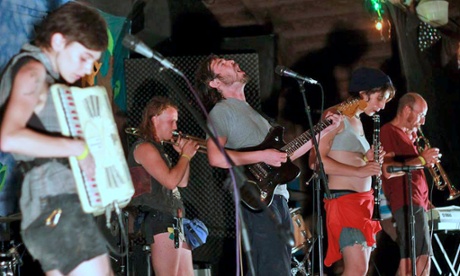
If there is one ethos of punk, and especially DIY (Do It Yourself) punk, it is that the punk world is for everybody: anyone can sing, anyone can play, anyone can listen, anyone can participate.
But in reality, men run the scene, men are the scene, and men always have been and probably always will be at the center of the scene. As a trans woman, sometimes I just go through the motions: I do my work, I perform my best, I seek out my moments of joy.
But it’s never perfect, and it’s occasionally awful: without warning, in the audience or on a stage, I’ll hear someone say, “This song is about feminism, which means: How hard it is to have a vagina in this world!” or “I saw Ralph in a dress the other day, that was pretty funny” or “That last songwriter, he was pretty cool”. And I’m suddenly rocking out here on the outside, but only listening in on the thing I love. And even if I don’t walk out, I’m still gone, excluded from the supposedly ultra-inclusive community I’m trying to build.
If you want – and most people do want – you can retell the early history of punk exclusively by referencing white men: Johnny Rotten in London, Joey Ramone in New York, Henry Rollins in Los Angeles, and so on and so forth. When you look between the gaps, of course you find women and people of color everywhere: Death and Algebra Mothers in Detroit, X-Ray Spex and Genesis Breyer P-orrige in the UK, Bad Brains and Jayne County around the US, and of course Ron Reyes, Dez Cadena and ROBO of the all-too-often whitewashed Black Flag. But that’s exactly the problem: we find these important, influential, wonderful groups in the gaps. They’re marginalia in the “real history” while the boy-bands get to be “real punk”. My peers can write ’zines, make comics, compose essays, but they’re somehow not punk enough.
Maybe that’s because certain punk men built their scene on images of violence against the established order and, while the genre hasn’t yet torn down the state apparatus, it has enacted that state’s violence on the lower class, nonwhite, disabled and non-men folks in the scene. No matter how many dialogues we stage on anti-oppression, safer spaces, radical inclusivity and mutual aid, men in punk can still stand in front of a crowd and scream about almost anything they want or feel – just so long as they avoid a given list of anti-oppressive no-no words. Their power has put on a more pleasant face, but some men remain a fundamentally violent presence that I must witness if I want to be a part of the beauty of the scene.
I love the punk music that’s coming out now – I even love the people making it. But I don’t trust them or their work. When you’re a trans woman, you learn to keep your expectations low and your hopes at arm’s length.
My first tour was me and eight men for two weeks, playing community spaces, rocking basements, selling weird merch, the whole thing. And I was astounded at how good I felt around those men: we didn’t talk about my gender, they didn’t call me “he” and I somehow managed to feel “normal”. I called their silence about me respect, and called my own silence about them the price of belonging. I fell asleep on strangers’ couches and hoped I’d be safe; I sat through hours of aggressively male banter; I told the breathless boys who moments before had been barreling into me, knocking over my mic, and cutting open my lip, “Thank you, thank you for coming, great to have you here.”
And yet there are joys: I’ve joined more bands, kept queer punks close, and I’m closer and closer to touring full time. When I come home, the DIY scene in Worcester, Massachusetts, takes excellent care of me, and I play for them and they play for me and we call that a life. For the first time in my life, I can list people like me whom I admire, and whom I can try to emulate in my work: Sybil Lamb, Imogen Binnie, Noel’le Longhaul, Rosanonymous, the departed Samantha Jane Dorsett.
DIY punk – with its self-released music, non-corporate labels, cheap all-age shows in basements – embraces those things not as means toward corporate success, but as intrinsically worthwhile tools to build authentic rebellion and powerful community.
Still, I watch my peers in DIY stage communion with audiences who pay for a touch of our emotional lives, our pay-what-you-can consumer ethics enabled by the economic stability of middle-class musicians and fans; our authenticity built on false premises of what it means to be “true” to punk in a messed-up, still-exclusionary scene made up of mostly white, abled middle-class men who make and buy most of the music.
However anti-establishment in spirit, punk has always been tied to money: success means getting signed, getting famous, getting a world tour. Even if rebellious energy or violent imagery remains in the music, economically speaking, punk is just another sales category to the male-dominated establishment.
Meanwhile, punks like me, and those unlike me – punks of color, working class punks, disabled punks – struggle to get what most men in our scene are all-but automatically granted: not just power, but meaning. They get to be their whole, authentic selves on stage and off, they get to decide what’s punk, they get to “let” the rest of us in. To break into their scene doesn’t feel like a success; rather, it feels like being give permission to play along when I shouldn’t have needed to ask. Not in punk – and not anywhere.

